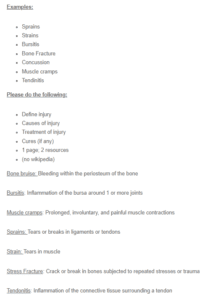Sports Injury – Bone Fractures
Bone fractures are among the most common sports injuries, especially in contact sports. A bone fracture is a break in a bone due to a one-time or quick injury. The main types of nine fractures include acute, compound, growth plate, and stress fractures. Acute fractures are caused by a blow to the bone, and their severity depends on the force that caused the injury. Next, compound structures are caused by injuries that extend beyond the skin. Further, growth plate fractures occur near the end of long bones. Notably, long bones consist of a shaft, an expanded portion, a hyaline cartilage layer, and a widening part between the extended portion and the shaft (Shier et al., 2019). Growth plate fractures are common because the growth plates are vulnerable to breaking until they develop into bones. The main cause of growth plate fractures is single traumatic events such as a fall. Are you interested in obtaining quality help in nursing assignments? Contact us.
Fourth, stress fractures occur in the fibula, tibia, femur, and foot bones. The main cause of stress fractures is repetitive impact and regular jumping or running because such activities create forces three times or twice what a person weighs on the lower limbs (National Institute of Arthritis and Musculoskeletal and Skin Diseases, 2023). Stress fractures are, therefore, common among players in sports such as basketball, tennis, and gymnastics because they involve running and jumping.
The treatment of bone structures depends on the type and severity of the fracture. However, the most common treatments include splints to stop the movement of broken limbs, surgical insertion of plates or metal rods to hold the fractured bones together, plaster casts to immobilize or support the bone, and braces to support the bone. A broken long bone may be treated by nailing the bone internally, placing the broken part in a cast, and plastering. Individuals who experience bone fractures are advised to rest to facilitate self-healing because there is no specific cure for broken fractures. Proper rest creates enough time for the bone cells to form inside the fracture line. The bone cells continue moving toward the center of the broken bone until the fractured bone heals.
References
National Institute of Arthritis and Musculoskeletal and Skin Diseases. (2023, July 27). Niams health information on sports injuries. https://www.niams.nih.gov/health-topics/sports-injuries
Shier, D., Butler, J., & Lewis, R. (2019). Hole’s human anatomy & physiology. McGraw-Hill Education.
ORDER A PLAGIARISM-FREE PAPER HERE
We’ll write everything from scratch
Question

Sports Injury – Bone Fractures
Examples:
- Sprains
- Strains
- Bursitis
- Bone Fracture
- Concussion
- Muscle cramps
- Tendinitis
Please do the following:
- Define injury
- Causes of injury
- Treatment of injury
- Cures (if any)
- 1 page; 2 resources
- (no wikipedia)
Bone bruise: Bleeding within the periosteum of the bone
Bursitis: Inflammation of the bursa around 1 or more joints
Muscle cramps: Prolonged, involuntary, and painful muscle contractions
Sprains: Tears or breaks in ligaments or tendons
Strain: Tears in muscle
Stress Fracture: Crack or break in bones subjected to repeated stresses or trauma
Tendonitis: Inflammation of the connective tissue surrounding a tendon

